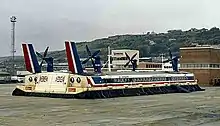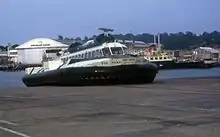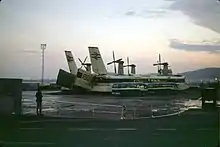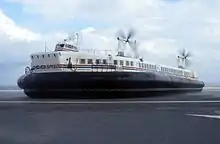Seaspeed
Seaspeed was a British hovercraft operator which ran services in the Solent and English Channel between 1965 and 1981, when it merged with a rival to form Hoverspeed.
 | |
| Industry | Passenger transportation |
|---|---|
| Fate | Merged with Hoverlloyd 1981 |
| Successor | Hoverspeed |
| Founded | 1965 |
| Defunct | 1981 |
| Headquarters | Dover, Portsmouth, United Kingdom |
Area served | Strait of Dover, Solent |
| Parent | British Rail |
Seaspeed was a jointly owned subsidiary of train operators British Rail (under British Rail Hovercraft Limited) and France's SNCF, and was established in 1965. Seaspeed operated several services; its first route, running between Cowes and Southampton, was launched on 6 July 1966. Initially operating a fleet of SR.N6s for these short-distance services, it opted to procure large SR.N4s to launch its cross-Channel ferry service; the first of these hoverferries was introduced in 1968. On this route, Seaspeed competed against traditional ferries and rival SR.N4 operator Hoverlloyd.
In 1976, after concluding that it could not attain suitable profitability from its smaller SR.N6 services, Seaspeed sold these to rival hovercraft company Hovertravel. Focusing upon its cross-Channel service, it opted to repeatedly upgrade the SR.N4 fleet. During the late 1970s, Seaspeed introduced the stretched SR.N4 Mk.III, greatly increasing its capacity; it also introduced a single French-built SEDAM N500 hovercraft, although the latter's performance was found lacking and it was returned to SNCF after only a few years. During 1981, in response to intensifying competition and rising costs, Seaspeed decided to merge with its historic rival Hoverlloyd to create the combined Hoverspeed. This new entity continued operated the SR.N4 fleet for many years, finally withdrawing hovercraft services in 2000.
Background and formation
During the late 1950s and early 1960s, British inventor Sir Christopher Cockerell had, in cooperation with British aerospace manufacturer Saunders-Roe, developed a pioneering new form of transportation, embodied in the form of the experimental SR.N1 vehicle, which became widely known as the hovercraft.[1] British manufacturer Saunders-Roe proceeded with work on various hovercraft designs, successfully developing multiple commercially-viable vehicles in the mid-1960s. These included the SR.N4, a large cross-Channel ferry capable of seating up to 418 passengers along with 60 cars, and the SR.N5, the first commercially-active hovercraft.[2]
Various operators became interested in operating hovercraft across various routes, including the highly-trafficked ones across the English Channel between the UK and France. Nationalised railway operator British Rail, which already had its Sealink ferry company as a subsidiary, was one such company; its interest was likely to have been heavily influenced by a political decision by the Ministry of Technology to establish a publicly owned hovercraft operator, in addition to strong interest from other commercial operators.[3] During 1965, it entered into discussions with various would-be partners, including the British Overseas Airways Corporation and British European Airways.[4] Having approached French railway operator SNCF, the two train companies decided to jointly establish a new venture to enter the market upon.[5] Accordingly, in 1965, British Rail Hovercraft Limited was established; although it would be another three years before it launched its cross-Channel service.
One of the first decisions taken by Seaspeed's management, announced in November 1965, was its commitment for the Saunders-Roe's SR.N4; in fact, the company agreed to acquire the first example, which was essentially a prototype, and thus would serve as the type's launch customer.[6] According to authors Robin Paine and Roger Syms, the selection of the SR.N4 had been a foregone conclusion and that the predominant reason for the company's formation was to operate such a vehicle.[7]
Cross-Channel

Seaspeed investigated various options for its intended services, intensifying its evaluation efforts in 1967.[8] Management was keen to align with existing Sealink services so that, in the event of a vessel's failure, it could be more readily substituted for; thus either Dover or Folkestone on the English side and Calais or Boulogne-sur-Mer on the French side became the preferred options. However, Folkestone was eliminated due to its small harbour and high exposure to southerly winds.[9] SNCF, being keen to support the initiative, offered to build a railway line and station adjacent to the proposed Boulogne hoverport at its own expense.[10]
During August 1968, Seaspeed commenced its cross-Channel services from Dover, England to Calais and Boulogne-sur-Mer, France using its first SR.N4.[11] Its first two SR.N4s were named The Princess Margaret and The Princess Anne respectively; the former featured in the James Bond film Diamonds Are Forever.
Seaspeed was not the only hovercraft operator that decided to move on the cross-Channel market at the time; a rival company, Hoverlloyd, was also established in the 1960s and launched its own competing route between Calais and Ramsgate. The two firms would compete with one another, as well as incumbent ferry operators, for market share throughout Seaspeed's existence.[12] Despite this rivalry, considerations were made towards mutually beneficial cooperation; at an early stage, Seaspeed's management considered conducting SR.N5 services out of Hoverlloyd's hoverport at Ramsgate.[13]
In early 1976, the British Rail board approved a plan to drastically upgrade the two existing SR.N4s by lengthening them, achieved via the insertion of an almost 17.1 metre (56.1 ft) long section.[14] This change increased the passenger capacity of the craft from 254 passengers to 418, while also having raised the car capacity to a total of 60. According to Paine and Syms, rival operator Hoverlloyd was interested in the modification, but did not have such work done to their own SR.N4 fleet, allegedly due to a lack of available finances.[10]
Isle of Wight

Seaspeed also operated passenger-only services across the Solent using a pair of smaller SR.N6 hovercraft, named Sea Hawk and Sea Eagle. This service, running between Cowes and Southampton, commenced on 6 July 1966.[15] This initial route was later joined by Portsmouth–Ryde and Portsmouth–Cowes services starting from Portsmouth Harbour railway station.[16] By mid-1967, Seaspeed's Solent services had carried 67,600 passengers, the Southampton-Cowes route proved to be the most trafficked of the three services.[17] The Southampton terminal was on the west side of the river Itchen just upstream of the floating bridge terminal. A bus link connected the service to Southampton Central station.
Seaspeed made various alterations to their smaller services over time. Between 1968 and 1972, trials of the 67-seater Hoverspeed HM2 craft were conducted, but the company concluded it to be unsuited to its routes.[18] By 1972, Seaspeed's SR.N6s had been stretched and furnished with uprated engines to increase their capacities. However, the company eventually concluded that the SR.N6s were too expensive to run to achieve a sufficient return on investment on any of the three Solent routes.[18]
During 1976, the Solent routes were transferred to rival hovercraft operator Hovertravel, which already operated its own services in the area. During 1980, Hovertravel decided to entirely discontinue the Cowes-Southampton service; this move was attributed both to rising costs and increased competition on the route from watercraft such as hydrofoils and catamarans, opting instead to concentrate its resources on its Ryde-Southsea service, which was viewed as more commercially viable.[19]
Economics of large hovercraft operation

Each SR.N4 was powered by an arrangement of four Bristol Proteus gas turbine engines; while these were marinised and proved to be one of the hovercraft's more reliable systems, they were relatively fuel-hungry, consuming significant amounts of aviation-grade kerosene.[20] As the worldwide oil crisis of the 1970s caused fuel prices to rise sharply, the operation of the SR.N4 became increasingly uneconomic.[12] Furthermore, the closure of the British Hovercraft Corporation restricted support options, meaning that maintenance of the craft became more costly over time, and that neither like-for-like replacements or improved successor hovercraft were likely to be developed.
Seaspeed (and later Hoverspeed) operated a single French-built SEDAM N500 hovercraft, designated N500-02, Ingénieur Jean Bertin, from 1977.[21] In concept, it looked to be a capable vehicle, possessing advantages over the SR.N4 such as storing cars over two decks rather than one. However, the N500 was beset by design and operational problems that would never be successfully resolved; following a somewhat sporadic service on the cross-Channel route, the N500 was permanently withdrawn during 1983 and later scrapped.[22]
Various duty-free goods were sold onboard the SR.N4s during their cross-Channel transits.[23] These sales comprised a meaningful portion of the service's overall revenue, therefore the company strongly emphasised the importance of onboard sales amongst their staff. The abolition of duty-free sales during the late 1990s further diminished operating income and contributed to the fleet's withdrawal.[23] Increasing staffing requirements brought on by the implementation of new legislation and actions by trade unions also contributed to the craft's increasing operating costs.[24] Fresh competition from high-speed rail services, facilitated by the completion of the Channel Tunnel in 1996, undermined the SR.N4's speed advantage, drawing passengers away and further decreasing the service's commercial viability. These combined factors gradually worsened the SR.N4's economics as time progressed.[23]
Merger and rationalisation

By 1980, it was obvious that cross-Channel hovercraft operation could only continue economically if the two operating companies merged, with consequent rationalisation. Therefore, in 1981, Seaspeed and Hoverlloyd merged to create the combined Hoverspeed following the granting of permission by the UK's Monopolies and Mergers Commission.[25][26][27] The former Hoverlloyd services from Ramsgate were subsequently withdrawn after the 1982 season and the four ex-Hoverlloyd craft were thereafter based at Dover; they were gradually withdrawn from service between 1983 and 1993 to be used for spare parts for Hoverspeed's remaining SR.N4 fleet. In 1991, it was announced that the SR.N4 service would be eventually phased out entirely in favour of catamarans.[12]
Hoverspeed continued cross-Channel hovercraft operation until October 2000, when the last two SR.N4s were withdrawn and the era of 'hovering across the Channel' came to an end.
All four ex-Hoverlloyd craft were eventually broken up and none remains extant. One ex-Seaspeed SR.N4 craft, The Princess Anne, remains and is stored at the Hovercraft Museum, Lee-on-Solent. For a time, the hoverport at Pegwell Bay was used as an engineering and administrative base by Hoverspeed after passenger services had ceased, but the site was eventually closed and the buildings demolished.[28] The hovercraft pad, car-marshalling area and approach road are the main identifiable features that remain at the site.[12]
See also
References
Citations
- Paine and Syms 2012, p. 82.
- Paine and Syms 2012, pp. 238, 595.
- Paine and Syms 2012, pp. 200-203.
- Paine and Syms 2012, pp. 203-205.
- Competition Commission report Archived 2 March 2005 at the Wayback Machine
- Paine and Syms 2012, p. 202.
- Paine and Syms 2012, p. 205.
- Paine and Syms 2012, pp. 229-231.
- Paine and Syms 2012, pp. 230-232.
- Paine and Syms 2012, p. 234.
- Paine and Syms 2012, pp. 307-309.
- "Hovercraft". BBC. 6 March 2006.
- Paine and Syms 2012, pp. 232-233.
- Paine and Syms 2012, pp. 555-556.
- Paine and Syms 2012, p. 226.
- Paine and Syms 2012, p. 227.
- Paine and Syms 2012, pp. 226-227.
- Paine and Syms 2012, pp. 227-229.
- "The History of the Hovertravel". Hovertravel. Retrieved 2 February 2020.
- Paine and Syms 2012, pp. 525-527, 547.
- Paine and Syms 2012, p. 554.
- Paine and Syms 2012, pp. 609-612.
- "Hovercraft Facts". 1966: Hovercraft deal opens show. BBC. 15 June 1966. Retrieved 9 April 2010.
- Paine and Syms 2012, pp. 567-570, 600.
- http://www.mmc.gov.uk/rep_pub/reports/1981/fulltext/138c01.pdf
- "Merger of British Rail Hovercraft Ltd and Hoverlloyd Ltd to form Hoverspeed UK Ltd". The National Archives, Kew. 1 November 1981.
- Paine and Syms 2012, pp. 616-626.
- Paine and Syms 2012, p. 14.
Bibliography
- Paine, Robin and Roger Syms. "On a Cushion of Air." Robin Paine, 2012. ISBN 0-95689-780-0.
External links
- Hovercraft services across the Solent, Antony Barton
